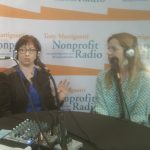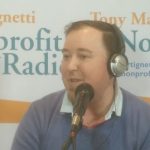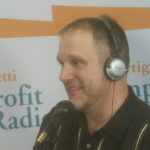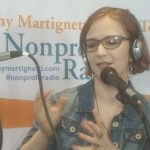I love our sponsors!
Do you want to find more prospects & raise more money? Pursuant is a full-service fundraising agency, leveraging data & technology.
WegnerCPAs. Guiding you. Beyond the numbers.
Credit & debit card processing by telos. Payment processing is now passive revenue for your org.
Fundraising doesn’t have to be hard. Txt2Give makes it easy to receive donations using simple text messages.
Get Nonprofit Radio insider alerts!
Listen Live or Archive:
- On Fridays at 1pm Eastern: Talking Alternative Radio and tune in
- Listen to the October 12, 2018 archived podcast
My Guests:
Anna Rhodes & Brenna Holmes: KPIs
 Our panel from the Nonprofit Technology Conference (18NTC), shares its wisdom and insight on using key performance indicators to build consensus around goals and measures for your nonprofit. They’re Anna Rhodes and Brenna Holmes from Chapman, Cubine & Hussey.
Our panel from the Nonprofit Technology Conference (18NTC), shares its wisdom and insight on using key performance indicators to build consensus around goals and measures for your nonprofit. They’re Anna Rhodes and Brenna Holmes from Chapman, Cubine & Hussey.
Amy Sample Ward: Fundraging
 Is your org positioned to accept help from supporters who are pissed off and want to channel their anger to something constructive, like raising money for you? Amy Sample Ward, our social media contributor and CEO of Nonprofit Technology Network (NTEN), explains what’s going on and how you can take advantage.
Is your org positioned to accept help from supporters who are pissed off and want to channel their anger to something constructive, like raising money for you? Amy Sample Ward, our social media contributor and CEO of Nonprofit Technology Network (NTEN), explains what’s going on and how you can take advantage.
Top Trends. Sound Advice. Lively Conversation.
Board relations. Fundraising. Volunteer management. Prospect research. Legal compliance. Accounting. Finance. Investments. Donor relations. Public relations. Marketing. Technology. Social media.
Every nonprofit struggles with these issues. Big nonprofits hire experts. The other 95% listen to Tony Martignetti Nonprofit Radio. Trusted experts and leading thinkers join me each week to tackle the tough issues. If you have big dreams but a small budget, you have a home at Tony Martignetti Nonprofit Radio.
Get Nonprofit Radio insider alerts!
Sponsored by:
View Full TranscriptProcessed on: 2018-10-24T15:31:15.553Z
S3 bucket containing transcription results: transcript.results
Link to bucket: s3.console.aws.amazon.com/s3/buckets/transcript.results
Path to JSON: 2018…10…411_tony_martignetti_nonprofit_radio_20181012.mp3.343078114.json
Path to text: transcripts/2018/10/411_tony_martignetti_nonprofit_radio_20181012.txt
Hello and welcome to tony martignetti non-profit radio big non-profit ideas for the other ninety five percent under aptly named host oh, i’m glad you’re with me. I’d be stricken with gastro inter opto sis, if you brought me down with the idea that you missed today’s show kp eyes our panel from the non-profit technology conference eighteen ntc shares its wisdom and insight on using key performance indicators to build consensus around goals and measures for your non-profit they’re anna roads and brenda homes from chapman, cubine and husky and fund-raising is your organ positioned to accept help from supporters who are pissed off and wanna channel their anger to something constructive, like raising money for you ? Amy sample ward, our social media contributor and ceo of and ten non-profit technology network, explains what’s going on and how you can take advantage. Tony, take two thank you, responsive by pursuing full service fund-raising data driven and technology enabled tony dahna slash pursuing wetness e p a is guiding you beyond the numbers regular cps dot com bye tell us attorney credit card processing into your passive revenue stream. Tony dahna slash tony, tell us and by text to give mobile donations made easy text npr, to four, four, four, nine, nine nine here are and erodes and brenna homes with k p iis. Welcome to tony martignetti non-profit radio coverage of eighteen ntc non-profit technology conference in new orleans. This interview is sponsored by network for good, easy to use, dahna management and fund-raising software for non-profits. My guests are on a road and brenda homes. Anna is deputy director of analytics at chapman cubine and husky, and brenda holmes is vice president of digital at c c h ladies. Welcome. Thank you. Glad to have you both have you. Have you done your session already ? We did. We just just finished, finished all your coming off it, all right, it’s coming off the hyre exact. The bar is open now. Life is good. You’re topic was, but are we making progress, establishing and using kp eyes ? Okay, uh, maybe we’ll start with, make sure that everybody understands that a k p i is a what you stated in unison together, keep performance in the caner. We see that the voice okay, i think that’s pretty well understood, but let’s, just make sure, okay, why are these things so important ? Let’s start with anna because, er it is so hard to keep everyone within a non-profit hyre working towards the same goal instead of looking at all of their different measurement. Um, so having a way to agree on what success really looks like can actually end up making you be more successful in the end, because then you’re all working towards the same goals. Okay, so the part of this topic is organizational buy-in or we’ll not organic. Yes, whatever happens, you fire of you defined focus, a bunch of people, a bunch of people need to agree, so called that buy-in okay. And i also see another part of this is data overload. I mean there’s, just so much available, right. We need to focus on brenna on what’s what’s, the most important stuff. Exactly. Yeah, and the main thing, you have them clearing up the misnomer that not all kept metrics are kp eyes, right ? So everybody does have to agree. On what what are we trying to track ? Why are we tracking it ? How does that help us meet our strategic objectives and our end goals, right. So once you have the buy-in on all those goals, then you’re able to dig down deeper and develop. What are those specific metrics that will help us meet these kp eyes that we can then measure against those strategic objectives to ensure that we do have success and that we are tracking over time ? Okay, okay, very good, that’s, great, overviewing, thank you. Alright, so. Well, should we should we start with our so we started our organizational goals. Yes, because that’s what ? We’re measuring against that, you’re just saying that. So now we got to get okay. So this all obviously should flow from our mission. I’m gonna go back to that. That that that fourteen year old voice, that really reason that we exist our mission statement. Okay, from that, we have gold now. Now. Okay, i’m gonna assume that everybody buys into the mission. Otherwise they wouldn’t be working there. Hopefully. But now now way. Get to the goal stage people could start falling out. That’s where the disagree it’s not too far from mission to gold, but we could start losing people. What do we do ? Go ahead, runner. Yeah, i’m gonna start so we we like to focus it on the building. Kind of smart goals, right ? So what do we need to do ? Departmental e department by department to help us achieve our mission on dh. Really phoning it in tow ? Really ? No. More than two. Three. And i went up to five in our session. I was like, oh, but, you know, two, three things that we all can agree on as a group that these are priorities. These are important goals. And, yes, there’s. Other things that are important. But if we let ourselves go down the rabbit hole of just saying, listing everything that’s important now, things no longer important, which is what you’re starting with you yours, referring to earlier with the data overload and it’s, especially. Eazy, because digital metrics can be so different than offline metric to instead have the i’m actually moving it away a little bit, okay, okay don’t worry, it can actually be easy. Tohave the metric create new divisions within just the development department divisions that didn’t even exist before, but it’s sustainers causing problems in solving so a cz longest. You’re looking at twenty things in google analytics and through the facebook manager over here, and then a completely different set of metrics for direct male you’re not even working towards the same goals within the development department. So that’s part of why so important to start at the goal side of things rather than at the measurement side of things, so that the measurements always air serving the goals supporting those goals, right ? Okay, i imagine we need top down by this has got to come from leadership. That’s the goal agreement we still go agreement it’s got to be driven from above and and accepted. Yes, it doesn’t necessarily have to be driven from above but don’t really actually, i was you know, as i was saying, i think it could be bottom up it can be, but but but the leadership has to be on a great okay. Okay, for sure. All right. Uh, all right. So we agree on our goals. Now, now we’re moving to our kp eyes. How are we going to how do we know what that’s measurable belongs at the top within within these goals ? Yeah, that we’ve all agreed on. Well, and even before you get teo, what are the kp eyes ? We need to develop strategic objectives for each goal, okay ? Because the girls tend to be a little bit umbrella there. Vega. Right way. Operation. Exactly like we use greenpeace. One of our clients in our session today partnered with us, and one of their goals is defending democracy. Okay, well, that’s big right and an existential and long and yeah, eso then we developed strategic objectives that will help them measure against whether or not they’re being successful in duvette defending democracy it’s time for a break pursuant there. E book is fast non-profit growth stealing from the start ups. They take the secrets from the fastest growing startups and apply those methods and practices to your non-profit it’s free as you’re accustomed to all the pursuant resources. Are and it’s on the listener landing page ? No surprise, tony dahna may slash pursuing capital p for please and pursuing i guess now back to kp eyes from the non-profit technology conference. So what are you ? What are some of them that they chose so way ? Work through those greenpeace ? How come that on right now is accident or not at this table ? Alright, now they’re long sorry, it’s not proper radio your life. I know, i know, but we worked through them from the department perspective. So what would it mean for the fund-raising department to be supporting the organization goal of defend democracy ? So it is easy for fundraisers to think that their job is always the same. It is always just raise money, raise lots of money and then we’re done. But there actually is more nuanced than that if we’re trying to defend democracy. Well, sadly, that isn’t something that we’re just doing today or for the next month. That’s actually a long term project and certainly at least through the trump presidency. And and, you know, given how greenpeace defines this goal of actually reducing the amount of money in politics, i mean that’s going to take sometime. So that means whatever funding that fund-raising is supplying has to be sustainable and it’s the net that matters, not just the growth tomorrow. Okay, so that means now we’ve clarified the objective in the fund-raising department. So that’s, the next stage come up with the mission statement for the organization ? We’ve turned that into a number of goals for the organization, the big dream things defend democracy, stop global warming, all of these huge concepts and then we’ve broken them down for how does my department contribute to that ? And on lee, once you’ve done that, can you decide ? What am i going to measure what’s actually being, what do i need to measure ? Ok, right. So the object’s strategic objective is growth in sustainable net revenue. We’ll both sustainable and net are two measurable things. So then you can build your kp eyes off of those keywords on dh actually, decide on what are the metrics that we have to check ? How do we agree on collecting that data so that everything has a flat, measured baseline that we can then benchmark ourselves against what periodically so that we’re checking in on that growth ? Side of the goal and when we’re at this stage, is this just our department ? That’s that’s really making these decisions ? Okay, so we’re not we’re not at the higher levels anymore. It’s not necessary, correct is where the department level, but we’re going to build back-up so we’ve gone down to the department level to figure out that’s, so i mean, you’re using your expertise, so you want your fundraisers figuring out how fund-raising can best support the fund-raising goal, right ? You don’t i don’t want a cfo deciding that, but in the end, the cfo has two buy-in on it, all of leadership does have two buy-in so once the various organizations have figure out out their objectives and their kp eyes, then you have to come back up a level and talk across departments and see how these objective support each other and possibly adjust them is where we ended up with our greenpeace example is actually making slight objectives when the marketing department and the fund-raising department saw the amount of overlap between their objectives and the tactics in specific that they were planning in order to get there, so that sounds like an ah ha! Moment, way. Have a lot more in common than we realized. A cross marketing and fund-raising. Exactly. Yeah, okay, okay. Okay, dahna, but let me ask you where should we go next with this ? Where do we go next with discussion ? You talk good. Well, i was just gonna say i think, you know, we used marketing and fund-raising as the example here because obviously, the ntc audiences, a lot of marketers and fundraisers, but the same structure and the same necessity for kp eyes it’s in all departments, right ? Whether it’s, your program, people who are actually implementing the services or whether it’s your public relations or media relations outreach people like all of these departments have to go through the same process on. And i think there will be a lot of those. Ah ha. Moments for organizations who are used to working in silos when they start thinking about the goals. Right ? Actually being achievable of strategic objectives that can be measured to get back against the mission on dh over there. Okay, uh, what about digital digital fund-raising kp eyes ? You talked some about that ? Yeah. Okay, let’s. Shut out. You want to start anna s. So there are a lot of questions about digital fund-raising kp eyes because people immediately go to the measurements available. In google analytics, and which one of these should i use as if the answer is the same for everyone ? So this just, you know, as if conversion rate on your petitions should be asserted number for every single organization and that’s what defines success ? Because we can show you how to set that up in google analytics, so that came up in our session, and it was a another reminder to folks to go back to the beginning, decide on your goals. Yeah, i think i feel like a lot of ways it’s, like the ultimate consultant answer is it depends right ? Because everything is it is individualized. If you’re not taking the time to audit yourselves and personalize and get that organizational buy-in and that organizational priority list, then they don’t really matter than they aren’t kp eyes, they’re just metrics, whether they’re showing growth or loss or what they’re just vanity numbers at that point because they have no tie to the strategic objectives in the mission of the organization. We had one question in the session, which was great, and it was about supporter scoring and i think that’s mental really hot topic in the digital. Space border scoring ? Yeah, i don’t know what that is. Okay, so when the ads taking basically qualitative, um, pieces of information, whether that behavioral traits or demographic things on dh scoring it, putting a quantitative wait to that to then build a model to show you these are my best people, my top ten deaths ill or my latto bottom ten on dh, then also using it to find lookalike audiences and things like that out in the world. So you want you’re doing this for different constituencies like donors, volunteers, exactly, event attendees, service beneficiaries, okay, different constituencies. And the problem is exactly the same problem that folks have with models in the direct marketing space is that for non-technical users, they hear model, and they’re like, oh, it obviously adjust to my program. It’s must have something to do with artificial intelligence. I hear all these things are great, these people are scored at the top, therefore they’re the best for me, and then they’re surprised when the results don’t match that. But any model has to be based on what your actual goals are, so if you’re using a response rate, a response based model and your goal is actually to increase high dollar donors. That model is not going to serve you. The people with the top score in that model are not necessarily going to be the high dollar donors. And so it was the same thing with the supporter scoring thie. It was a very good question, but it again starts from the data side of things rather than the gold side of things. We have all of this data. We have thes scores saying these supporters are our best ones. We should contact them every chance that we get our screening. Fill those right back. Yes, when i think a lot of it stemmed for for that, for a lot of people in for him in particular, asking the question that like which which one should i buy ? Right which model is best ? Which scoring which software should i purchase that you actually have to do the internal look looking in to find out what’s important to you before you decide what direction on demand that of the vendors ? Because it’s true, that all of these models can be adjusted when you are able to communicate what is actually valuable to your organization. Otherwise, you’re going to screen it. You mean screening ? Yeah. Yeah. That’s not commonly known. Now, i think i think most most orders say they just take the algorithms. Yeah, they’re provided the show. Andi. Everybody gets the same. Same right ? Yeah. Yeah, that that’s not leveraging that to its utmost. Yeah. That’s. A very good that’s. A very important point. I think people are just taking it and they figure well, there there’s a half a dozen vendors. So there are each have different a proprietary algorithm way. Have to pick one, right ? Not so. And not so you can. You can negotiate. Oh, yeah. I got a chorus thing just like the k p i s started you off area that’s. Two songs together. Ask for what you need and it doesn’t matter what how big the screening of doesn’t matter whether martin lundy or blackbaud or know it it is it is going to affect of the pricing, but asking the question it does not affect the pricing. So always asked the question of these air the things that are important to us. What would that mean for the price that you would offer on the model that you built that incorporates these things that are important to us. So find that out from a few different vendors when i was a good partner vendor is going to ask those questions of you the best ones will write they don’t know because they do try and have everybody tries to have an off the shelf product that’s going to be successful for the majority of users, but really the ones that are caring about donor-centric communication and really carrying about long term relationships with the non-profit that they partner with should be asking those questions because it is about building that custom model based on the weights and measures that are important to each of the organization and each individual program or department in the organization. Okay, in my experience, that’s it’s not surely aspirations on night. I’m an optimist. Yeah, there’s optimism and then there’s today i think you know that saying, you know, you know, but i just haven’t experienced it. I know i’m working planned e-giving fund-raising so i’m not, you know, i don’t have all the conversations with potential screening vendors, but i just have never heard this that you can negotiate. On tweaking tweaking of the yeah, i’ve never heard that i’ve always you know, i say whether it’s your own professional development like negotiating raises or what but if you don’t ask, you get everything is negotiable. Everything’s negotiable think lorts in london was negotiable. And speaking of an analyst there’s nothing that i like better than being told exactly what your goals are so that i can build something that it’s really going to be successful, right ? Yeah, that’s the battle them to anna and say, show me these numbers, right ? I come to and i say, i’m trying to figure out this about this co owners this i’m trying to figure out the answer to this question, and then she comes back to me with the metrics that solve for x better than actually just telling me ac okay, yeah, well, we still have ah, good number of minutes together left. What ? What else ? Maybe other questions that got asked or other things that came out of your that were in your session that we haven’t talked about yet ? What else is there ? Well, one question that i got wass what software solves this ? I’m paraphrasing, but basically it was what what do i buy that will make this ? Um but thiss kp i process ? Yeah, are there ? Are there tech solutions way ? Haven’t talked about that at all ? No, i don’t think everybody just wants that easy answer, right ? Nobody likes introspection, and there are tons and tons of software programs that can display your kp eyes, so if you’re looking for a data visualization, a solution that board a dashboard product there’s tons and tons of thumb out there and what i told this person was that if your issue is that you don’t have the staff, teo, learn new software and you don’t have the budget to buy something that isn’t going to solve all of your problems. Then don’t buy anything, put your kp ice and excel, but, um, in a word, doc, if you have and it really is the process and the conversations and having thie organization wide agreement that makes this powerful not you know all, i’ll create some great visualization for you, but i can create plenty of great visualizations using meaningless data. Some some some of this discussion reminds me of ah, strategic planning discussion still mean you’re getting organizational buy-in we’re all agreeing on common goals and the measures toward those goals. I mean, those goals inform the future direction of the of the organization. So there’s overlap between this and a strategic planning process. Yeah ? Oh, definitely. Yeah, and that was a big part of it. The draw. When ana came up with the session idea, i thought it would be she roped you in ? Well, no, i basically solicited her. But then she came up with the idea because ntcdinosaur like solo. So i mean, i don’t know, but i’m the one that speaks of these things all the time. And i was like, anna, your turn. But it was her idea. The session was great and i just fell in love with it because it’s not just about numbers, right and that’s what people think that’s always important question. Exactly agreement. It really is about the change. Even change management, strategic planning like all of you respect exactly. And that’s, i think is. So is it lost on a lot of people, especially at non-profits ? Where everybody’s wearing ? A lot of hats, everybody is doing multiple jobs and just trying to get the next thing done on the list that this really forces you. If you want to do a right to take a step back and think about how your day to day activities impact the mission, impact the strategic objectives and on go from there and i think that’s, i think that’s really refreshing for people to do just in general, whether you’re developing kp eyes or not, because it does make you think about why we do what we dio and people who work in non-profits as well as those who partner like us, who partner with them, we do this because we love right now work the outcomes of the mission that zit and we all get so tied up in the weeds of the day today that we forget about the mission and how amazing the organizations that we work with. Our and people have a very hard time because they’re wearing a million hats, hats, and they have way too much on their plate. They just need to get that next e mail out so that they have a very hard time. Deciding okay, today i’m going to stop and actually go through this k p i building process, but i would urged people to try it because, uh, wait, we have a couple minutes left, and i think we talked a lot about motivation. Hyre logistically, how do you take this on you ? We meet once a week, tio i mean, he’s, a big topic you can’t you can’t do this in a in a week now, but you meet once a week, over months or a couple days over every other. How did you do this ? Logistically, i would suggest tacking it onto the front of your annual budgeting process, so work back off from when you’re budgets are due to the board, and then when their due to your department lead and due to leadership, and then give yourself a minimum of a month, but ideally two months so it’s, like not unusual for to be a six month process from the time of the department objective and kp i development to the time that the budget is actually finalized and signed off on by the board. Okay, excellent, helpful and that forces you to revisit on at least. On an annual basis, right, because you’re reevaluating before that next expenditure budget is good into place annually now, okay, okay, yeah, we have, like a minute and a half left. I wantto make sure this fits just right. So where ? Who wants to leave ? Leave us with closing thoughts. You know what else to say ? Okay. I wish i had something easy. Tio. You’ve seen this working clients, right using transformation and clients in the process can work. Yeah, stamina. Devote your vote attention to it. And i have seen it make those data day tasks easier, because then you have fewer interruptions from other departments or from leadership trying to push you in a million different directions. Dahna. Okay, it’s. A really good point. That’s. A good place. Alright. Thank you. Thank you. Love are well done. Wonderful. Okay, thanks. They are on a road. Deputy director of analytics chapman, cubine and husi. And also brenholz vice president of digital at c c h. The interview is sponsored by network for good. Easy to use donorsearch and fund-raising software for non-profits. Thank you so much for being with tony martignetti non-profit radio coverage of eighteen ntc. We need to take a break. Wagner, cps. Do you need help with accounting or your nine ninety ? Are you thinking about a change of accountants in this ? Ah, next in the next cycle for yourself. Check out weinger cpas. Dot com. You start your due diligence there, of course. And then talk to them. The partner ? Yeah. Huge tomb. You know, he’s been on the show. He’s a good guy. I trust him weinger cpas dot com the place to start now. Time for tony steak too. Do i say thank you too often ? If i do, please let me know, but i’m saying it now. I am grateful that we have the support we have now over thirteen thousand listeners, whether you are listening, live podcast or affiliate thank you if you’re following along on twitter. If you’ve, uh you’re following what we call it on youtube is just following subscribing if you subscribed on youtube twitter, youtube i thank you facebook, facebook, facebook fans! It doesn’t mean much anymore. It seems to have very much faded into sort of triviality. I remember the days we used to say like us on facebook. Facebook dot com slash twenty monday now provoc radio those were the dark days, but i’m grateful that’s it. Thank you. However you’re with us. Thank you very much. It’s. My pleasure to welcome back amy sample ward. You know her for god’s sake, she’s, our social media contributor in the ceo of and ten the non-profit technology network where we just heard a segment from for the last conference her most recent co authored book is social change anytime everywhere about online multi-channel engagement she’s that amy sample war dot or ge and at amy rs ward welcome back, amy simple word hi. Thank you for having me back. It’s always a pleasure. I am. I’m always waiting for the day when i just stopped getting invitations. Yeah, it’ll happen that way too. I won’t officially tell you. I’ll just stop course. Just slowly stop scheduling me and i will know it. It’s over. Yeah, i won’t even be slow. It’ll be abrupt. It’ll just have the thing. And then six months later, you’ll think about well, hopefully is not that long. Couple months later think packed. Jeez, tony hasn’t been in touch with me for, well, that’s the way it’ll happen. Um, okay, so we’re talking about fund-raising fund-raising underage. What ? Yeah. What ? Uh, put this on your radar. Well, you know, i don’t think it’s necessarily new. I think it is. Has old as the world of fund-raising, you know, centuries and centuries old. But it has been something that here and in ten. As as staff, we’ve been talking about a lot, especially in the last two year political climate on dh it’s the way that i would define thunder aging is you can think of it a bit a bit like peer-to-peer where it’s individuals it’s not necessarily on organization or staff members, people out in the community fund-raising and it’s, the fund-raising that happens or the campaigns that happen in response to things in the news, you folks in a specific geographic community care that something is being proposed or moving forward ? That’s going tio threatened a way that they live their life or the way that the organizations they support are able to do their work, and in response to that kind of anger, that rage, they want to feel like they’re doing something, and it doesn’t feel like there’s really anything that’s in their power to do in-kind of that complex world we live in of policymakers and government officials and all the way down to us citizens. And so they start a fund raising campaign to benefit those organizations that they support that they see as the ones who are in a position to try and make a change or support people experiencing whatever situation is happening. So it’s really driven by individuals reacting to the news, you know, whatever that news, maybe not saying that this is something that only happens in one kind of view or political party, but as as a country, i think we see these examples of fund-raising jane becoming more and more visible, bigger impact on dh more, yeah, so not new, but certainly amped up under thinks the twenty sixteen election and since donald trump is president certainly amped up on really throughout the country, but, you know, i even has they say both sides because i’m trying to get away from us being a polarized nation, but across all across all political spectrums amped up yeah, okay, okay, yeah, you know, there’s a there’s, a there’s, a sense that, right ? You know, it it comes from a sense of sort of incapacity, you know ? Yeah, i think it really is that powerlessness that i think a lot of communities feel where, where the ability to make policy or protect existing policy or change processes doesn’t feel like something they are ever a part of, and yet they’re impacted by the results of those changes and that powerlessness, i think, is part of that rage, right ? How could this happen ? But also, how could this happen and not include me when i am a person that is a part of this, and so a kind of counterbalance that there’s this feeling of ? Well, if there’s on top of us, you know that all donate five players surely will be able to pull those funds, you know, into this organization or into this movement that can’t help that a lot of this i think, comes from or is is related to what you and i talked about in august over marketing, you know, if if there’s if there’s an over marketing problem in the non-profit community, if we’re constantly at eleven on a scale of zero to ten, then you know where, where were guilty of amping up the amping up the rhetoric, right on dh, the passions and the anger and the outrage for sure, and, you know, we don’t have to go down that path, but i think fund-raising when done successfully and by successfully to meet a part of that means in conjunction with an existing organisation and you know kind of ah request or past that makes sense for them to move forward with when that happens. It’s, because organizations are not over marketing, right ? They are very clear there, very consistent. They are providing information that helped synthesize the news, the changes, the policies, whatever it is and demonstrates really clearly that they are part of the fight or the solution or the alternative path. And that way it’s clear for supporters again. You know, these aren’t necessarily campaigns driven by the organization’s. These air campaigns driven by community members who just are so fed up they want to do something. And so when organizations can be very clear and communication be very consistent about the the things they respond to in the news or the issues that they are going to speak about, it positions community members to know oh, my gosh, i’m so upset. You know, i heard this thing on the news, but i know this organization i support, i trust them. I know exactly what they do. I know exactly how they’re part of a solution that i want to see. I feel comfortable and confident starting to fund raise for them because i know where they stand, i know what they do, and i’m able to even borrow that language, you know, for my facebook poster for my, you know, fund-raising page and in a home run by the organization, they’ve given me the tools and resources to help me create a campaign, you know ? So exactly we’ll get to that because, you know, you want to have ideally you want to have these things in place so that the community is empowered. Exactly, yeah, do you because you want to benefit from this, you know, if your community is upset, there’s there’s a potential benefit for you if you’re working in that space ? Exactly. Do you have a sense of what ? What helps make thes campaigns more successful ? O or not ? Yeah, i mean, i think that like anything there’s going to be those examples that are true out liars on dh, you know, feel like magical unicorn rainbow fundraisers that happened, and we’re not necessarily trying to replicate those, but the things that you can do is an organization beyond what we were just talking about being really clear and consistent on the issues that you talk about, that you respond to in the news demonstrating and communicated kating, how you address those things do all of that, but also i think if you think about this as a peer-to-peer campaign that you’re just not launching, you want to go through some of the same steps, you want to make sure that as an organization you can take donations electronically, that you, you know, have that kind of donation button set up on your website, but also that your, you know, maybe registered on various other peer-to-peer donation platforms so that if people wanted to create a campaign for you, you’re in the system and they can, you know, attach to your profile and have the funds go to u s o that’s one kind of administrative step to take and then on a planning communication side of things, you want to make sure that you’ve done again some of those same peer-to-peer best practices, you’ve got some tool kits that are really easy to find on your website, really easy to follow that say, if you’re going fund-raising for and then you know, whatever your organisation’s name is, here are the things that we know are successful here’s what ? Our logo file is that people aren’t just making a version of your logo that’s not right here’s, you know our mission statement here’s what we’re doing on these kind of top five issues, whatever you think may end up being the things that kind of rage people into fund-raising for you, so you already have sametz tab lish talking points out there, so put some of those tool kits together on dh. I also think that it’s important to keep in that you know it doesn’t have to be a pdf. It could be a page on your website that is, quote unquote the tool kit. It could be a google dog, it could be whatever, but make sure it’s up to date and you’re including things that are even even for people who want to want to fund rage but don’t want to create a whole page for you somewhere or don’t want it to be a long term thing, but they’re kind of really easy to copy paste messages that point back to your donation form so even if they don’t have the capacity or or maybe skills and knowledge to set up a fundraising page for you, they could copy paste that facebook comment that says, you know, i support and ten this is what they’re doing on this issue here’s the donate link so that you can even get those folks, or maybe it’s the lighter end of the spectrum. We gotta take a break tell us you’ve heard from charities that referred companies for credit card processing, and they’re getting the revenue each month you’ve heard from the companies using tello’s for their credit card processing now can use more revenue that long stream of passive revenue that comes from the fees that tello’s urns from the companies you refer. Start with the video at tony dot m a slash tony tello’s. Now, let’s, go back to amy sample ward. You ticked off a whole bunch of things there, andi, you didn’t have to go, but you were concise, you know, like you’re reading the outline for your next book for this chapter, fund-raising because, you know, i think that it’s important to keep in mind as like an idea about all of this is that this may be different from how organizations may think about other fund-raising campaign is that often really successful ? Fund-raising campaigns community led fund-raising campaigns the organization’s air in the background, but that doesn’t mean the organizations were not actively a part of that campaign being successful, so you don’t have to be the star because you’re going to be the start that’s all the talking points or about how you are going to do this change and that’s why people air are fund-raising you don’t need to be the voice that’s saying all of that so don’t feel like once somebody starts, you’re goingto kind of publicly jump on that and and you’re helping them by being really public about it. That’s actually, what you can do to help them is to be in the background reach out to them, send them an email if you know who they are, you know, send them a phone call and say, what do you need ? Do you need more messages ? We have staff to do that, you know, do you need images ? We can give you some images, help them and give them the fuel to make their campaign strong and don’t feel like you need to step out in front of it. I mean, you want to provide the infrastructure and an ongoing support, but but i think we actually counterproductive if you stepped in and started dahna messaging within their peer-to-peer campaigns, right o for sure we’re going the merciful st makes people feel like, do you even really care about this ? Are you just doing itcause ? This organization had you right ? I’m injecting, it loses that, yeah, you lose the first piela the pier is now the non-profit non-profit to the person’s peers who are not their peers, you know, it’s, it’s, it’s too long a string to abbreviate you can no longer abbreviated ptp. So exactly and i think what’s important to remember to is that the path you think might be most obvious or even easiest may not be the past for them and that’s ok, if they want to really focus on email because that’s who they are and they, you know, send lots of e mails every day and that’s where they know people will open their e mail and read it don’t tell them they need to be tweeting, you know, don’t tell them they need to post on facebook whatever channel somebody’s most comfortable with let them go through that channel. And say, you know, instead of giving you really easy to use tweets, we will write, you know, paragraph chunks for you to use that are compelling that have links to resource is whatever it is that’s going to help them in their outreach on dh you just have to be flexible tete that. Yeah, again, it’s you know, it’s it’s offering support. I mean, the first p knows where the second piece all right, where they hang out. You know, they know my friends. I know my peers put it in the pdp what’s a good word. I was structure, but lexicon samson in the lexicon, you know ? So i know where my penis will like these hangout, so don’t don’t tell me what i gotta do. Of course not. You’re interfering and yeah, yeah, no, i’m great. Yeah, but peace that’s interesting. And i would love to put you on the spot in here. Your thoughts to tony is is the way that these kinds of campaigns justice we’re talking about really centering the people who are fund-raising and not the organisation. How that means they are different in the way that you recognize those donors and supporters. The way that you recognize the work of that campaign on the way that you take credit for those funds, i think there’s a lot of nuance in that give in the way that these campaigns often start the reasoned that people give to them versus give teo you as an organization. Right ? I think it’s important to remember people are giving to that campaign to that rage and not necessarily to you as an organization, even though they are giving he was an organization, right ? So how does that, you know, maybe require, as an organization, you have different practices for the way you recognize and think those donors and those supporters that maybe you do when you run other campaigns yourself ? Yeah, i don’t take well to being asked questions on my own show on your own. Show it sze tony martignetti non-profit radio way. You just made my voice crack. I’m so upset. I know i would say you i would say you need to defer to the to the first p the person who ran the campaign for you, i guess first. Are they willing to share contact info toe let you directly. Thank the donors. To the campaign, maybe one. That all depends. Where did those donations go ? Over there, where the donations happening on a platform where, you know the contact information with saves captured, renamed not you know, i think there’s a lot of kind of technical russians in there too. Okay ? But even if i did capture it on my e-giving form online, i still would ask the the person that person’s permission because they know their peers better, you know, then, you know, how would you feel ? Would you mind if we, uh, could we thank them ? Wei have the info, but we’re not going to use it unless you, you know, let us say something or could re send a message from you to them and, you know, maybe the two of us, right, send a combined thank you message. Maybe our ceo signs it and you sign it, you know ? So what i want that’s a really great idea for for some instances, because you’re then maintaining the same relationship you had during the campaign where your job is an organization was to give them what they needed. And now you’re reinforcing their leadership in the community by saying we’re going toe thank you. And if you would like to, you can pass on our message of things to your, you know, to the donors, but you’re kind of still putting them in the position as the leader instead of the organization. Yeah, yeah, they’re they’re in the lead. I mean, there, there. Yes. It’s there it’s there community that they were fund-raising from so, um, yeah, you wantto elevate them ? Absolutely, uh, that’s, my son and i think it’s also important. I mean, when we think about this, any kind of fund-raising campaign as list building and what that means for future cultivation, whether more donations, bigger donations or other actions, you know, kind of other ladders of engagement. I think there are a lot of instances in fund-raising jean situations where the people who feel kind of fired-up and are supporting that effort are doing it in the way that’s not visible to the organization, at least from a like database perspective, you know, they’re not signing up on the organization’s website. They’re not donating to the organization through a donation form that the organization has access to, so they’re not coming on to the list, but these are people who are fired-up and finding ways against through those leaders who are kind of calling their community action, too continue giving them more news, continue giving them updates even after the maybe donation phase of it is over, but not lose contact with those people and continue to go back to them to say, hey, you know, we got a million dollars, which is not unheard of in some recent examples of fund-raising, you know, we got a million dollars in a week it’s been a month here, the eighteen long years that we’ve hired, we just wanted to let you know, you know, or here’s work that’s happening because of this so that they continue to be in a place where there almost spokespeople for for that action now, and they are saying, hey, i just got this word from the organization, this has been the impact of what we did, and, you know, they get to be the ones sharing that news because you don’t have a way to connect with other people, so at least make sure you don’t lose contact with those that you d’oh, we got to take a ah last break. Text to give, you’ll get more revenue because they make e-giving easy for your donors. If your donor’s consent a text, they could make a donation. We’re talking about that right now, it’s, part of your infrastructure, it’s simple, affordable, secure plus the ceo chadband oid very smart guy he spent set up a smart company um, it’s easy to get the info text npr for non-profit radio to four, four four nine nine nine npr to four, four, four, nine nine nine we’ve got several more minutes for fund-raising well, i’m very glad of within the sample ward would it was one thing i wanted to bring up is a question that has been brought up here at staff when we’re having conversations about this world of fund-raising jane and that is that you can’t anticipate when it’s gonna happen because of the news of the death everyday tension between, you know, you don’t really know what’s gonna happen in the world every day in advance. And what does that mean, given that it’s september right now, when people are probably have already done or at least starting to do now their end of year campaign planning ? So what ? Does it mean if you were, you know, done months of planning all this work ? You’ve launched your end of your campaign ? It’s ? You know, november, december, you’re running this end of your campaign. Something happens in the news. It’s that moment, you know, it’s okay, at least in my opinion, open tio what you may think, tony, but, you know, it’s okay to me, if that means your end of your campaign comes in way under goal and you stop tweeting about it because it may be more important to focus on this other angle where your community is fired-up in a different way, then continuing to almost compete with your community’s interests on, and i think that can be hard in the moment to say, oh, my gosh, we did all this work. We have all these goals and expectations are bored, you know, wants to do x y and z, and now we’re not gonna send this, you know, email out or something, but depending on, of course, you’re going to have to gauge what the community’s responses and all of that. But it may mean that you do let go of that end of your campaign. And that has to be okay. Maybe there’s a way to combine the two so that you know, so yeah. I mean, i definitely think it matters what the universe is, what the community is trying to campaign around. I think you could definitely, especially for your organization willing to do it. I have it in real time and make that end of your campaign talking points aligned with the communities, talking points, you know, if it’s not a huge departure from what you needed, what you needed to say anyway, that’s yeah, i agree. I mean, i would i would try toe message it so that you can you can take advantage of the the outrage. And and as you’re saying, you know, message it into your end of year, you know, it’s that it’s a tough one, because, i mean, i know a lot of listeners have small organizations with, like, one, two, three, staff people and, you know, end of year is like, you know, way may not make payroll if if we don’t do a certain amount in the in the fourth quarter or a lot, a lot of times, you know, like the month of december um, so it’s it’s hard, you know, you gotta yeah, i don’t think that you know, on the first tweet from a community member, you know, manage, stan, you’re not doing now, you’re doing it lightly, but i’m just, you know, i’m trying to balance the i’m trying to balance, you know, what’s not competing with your community, what your communities anger is and what they’re talking about. Versace, versace, you’re own your own messaging for the biggest campaign of your year. Um, i’m trying out for a lot of organizations that have a diverse fund-raising kind of palate with maybe online fund-raising and end of your fund-raising and major gift that it is just filters into maybe how you balance or prioritize amongst that grid, like maybe you say, okay, well, our online fund-raising focus will be supporting these community members who are tryingto lead some campaigns and, you know, are offline is just going to focus on our major donors, and they it might be an opportunity that they feel more compelled because now they see other people, you know, are coming coming to support the same organization that may be a lower financial level, but it still means something, so i think it’s really, about how it plays into the mix. Dahna yeah, yeah, i agree. I’m just considering the balance on a zai know how critical certain campaigns, whether it’s fourth quarter or not, you can be teo teo, people in to those organizations that are small, like i said, you know, one, two, three before employees, you know, i worry about making payroll and making, making rent payments that can that can keep you up at night, you know, you know, um, okay, we still got a couple minutes left. About two minutes or so left before we let you go. What else ? What else should we be talking about for two minutes ? Well, you know, i would be curious outside of on ly fund raging the ways that organizations are also using the news for, i don’t know howto turn raging into the end of other words, but, you know, these air really important moments for organizations for what we were talking about before, with this building and ad ad advil raging, i really committed to making raging part of the word, but, you know, finding ways where probably a little bit more on the fly, which is always hard for organizations, whether they’re bigger, small but finding ways to say, ok, this thing was said, here’s, how we feel about it, you know, do you stand with us something that doesn’t have to have any material outcome from it ? You’re now not, you know, producing an event or launching a program because you’ve said something but ways to get your community feeling like oppcoll they are with you, they know where you stand, you are getting that information back from them to be able to maybe segment your list really dynamically to say, wow, all of these people responded to this news item this day and, you know, these people didn’t that’s another wayto plan for cultivation later. So i think even if your community isn’t necessarily starting fund-raising campaigns for you or you’re not starting fund-raising campaigns in response to the news, you can still be using things that happen, whether they’re local or regional, are at a federal level, help you get more information about who your supporters are, what they care about, how they, how they came to sign up for you so that you can again better reach out to them. But think about your list before you start sending out fund-raising messages later. Yeah, it’s, not it’s, not all about fund-raising wait, we’re gonna leave it there and you say the word you’ll find her at amy rs ward and just follow her for god’s sake. You see all this wisdom ? Get it on twitter at amy or it’s war and also amy sample word dot org’s. Thank you so much, amy. Thanks, tony, my publisher. Next week, jean takagi returns with his take on donor advised funds if you missed any part. Of today’s show, i beseech you, find it on tony martignetti dot com, responsive by pursuing online tools for small and midsize non-profits, data driven and technology enabled. Tony dahna slash pursuant capital p when you see piela is guiding you beyond the numbers. Regular cps dot com by telus, credit card and payment processing, your passive revenue stream, tony dahna slash tony tello’s and by text to give mobile donations made easy text npr too for for for nine, nine, nine. Our creative producers claire meyerhoff. Sam liebowitz is the line producer. Shows social media is by susan chavez. Mark silverman is our web guy, and this music is by scott stein. You with me next week for non-profit radio big non-profit ideas for the other ninety five percent go out and degree. You’re listening to the talking, alternate network, waiting to get in. Nothing. Cubine hi, are you interested in blockchain technologies and cryptocurrencies ? Then tune in here on talk radio. Got n y c with me, david every friday, eleven a, m twelve p, m eastern time. As we answer your questions and interview, great guests live on internet radio on building the blockchain where you can catch the blockchain revolution. You’re listening to the talking alternative net. Are you stuck in a rut ? Negative thoughts, feelings and conversations got you down. Hi, i’m nor in something potentially ater tune in every tuesday at nine to ten p m eastern time and listen for new ideas on my show. Yawned potential. Live life your way on talk radio dot n y c hey, all you crazy listeners looking to boost your business ? Why not advertise on talking alternative with very reasonable rates ? Interested simply email at info at talking alternative dot com. Are you into comics, movies and pop culture at large ? What about music and tv ? Then you’re in for a treat. This is michael dulled, your host on talking alternative dot com. I’ve been professionally writing comic books, screenplays and music articles from fifteen years. Catch my show secrets of the sire at its new prime time slot. Wednesdays, eight p m eastern time, and get the inside scoop on the pop culture universe you love to talk about. For more info, go to secrets of the sire dot com. You’re listening to talking alternative network at www dot talking alternative dot com, now broadcasting twenty four hours a day. Are you a conscious co creator ? Are you on a quest to raise your vibration and your consciousness ? Um, sam liebowitz, your conscious consultant, and on my show, that conscious consultant, our awakening humanity, we will touch upon all these topics and more. Listen, live at our new time on thursdays at twelve noon eastern time. That’s, the conscious consultant, our awakening humanity, thursday’s twelve, noon on talk radio dot. You’re listening to the talking alternative network. Duitz





 eport and CEO Mike Rusch shares the results from their survey of mostly small- and mid-size nonprofits, plus his recommendations.
eport and CEO Mike Rusch shares the results from their survey of mostly small- and mid-size nonprofits, plus his recommendations.









 Steve Rio has been researching the intersection of mindfulness, creativity and productivity. He’s CEO of
Steve Rio has been researching the intersection of mindfulness, creativity and productivity. He’s CEO of  Building on last week, Miriam Brosseau has on-the-ground tips for digital storytelling that break down your internal silos and resolve organizational frustrations. She’s like your storytelling therapist, from
Building on last week, Miriam Brosseau has on-the-ground tips for digital storytelling that break down your internal silos and resolve organizational frustrations. She’s like your storytelling therapist, from 